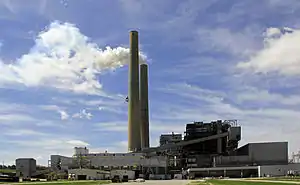A. B. Brown Generating Station
The A. B. Brown Generating Station is a four-unit, 700 megawatt (MW) power plant, located on the northern bank of Ohio River, 8 miles (10 km) east of Mount Vernon, Indiana and 5 miles (8 km) southwest of Evansville, Indiana just west of the Posey-Vanderburgh County Line.[1] Each of the two coal-fired units has a name-plate capacity of 265.2 MW. Bituminous coal is used as a primary fuel type, which can be substituted for natural gas.[2] There are also two gas turbine units, 88.2 MW of nameplate capacity each. The facility is owned by Centerpoint Energy (formerly Vectren, preceded by Southern Indiana Gas and Electric Company).[3] Vectren announced a plan to retire the plant in 2023 and replace it with a natural gas power plant; however, this plan needs to be approved by the Indiana Utility Regulatory Commission.[4]
| A. B. Brown Generating Station | |
|---|---|
 A.B. Brown Generating Station in 2011 | |
Location of the A. B. Brown Generating Station | |
| Country | United States |
| Location | Marrs Township, Posey County, near Mount Vernon, Indiana |
| Coordinates | 37°54′20″N 87°42′54″W |
| Status | Operational |
| Commission date | Unit 1 (coal): March, 1979 Unit 2 (coal): Feb, 1986 Unit 3 (gas): June, 1991 Unit 4 (gas): May, 2002 |
| Owner(s) | Vectren |
| Thermal power station | |
| Primary fuel | Bituminous coal |
| Secondary fuel | Natural gas |
| Turbine technology | Steam Combustion gas turbine |
| Power generation | |
| Nameplate capacity | 700 MW |
Environmental impact
Emission control
In 1979, Unit 1 was constructed with a dual-alkali scrubber to help reduce sulphur dioxide (SO2) emissions. In 1986, Unit 2 was completed and also uses a dual-alkali scrubber. From 2001 to 2005, Vectren installed four selective catalytic reduction (SCR) devices on all of the coal-fired units, which successfully cut nitrogen oxide (NOx) emissions by 80 percent. In 2004, Vectren replaced an existing electrostatic precipitator at Unit 1 with a fabric filter. The investment increased the particulate matter removal efficiency to 99 percent at that unit.
Ash ponds
The A. B. Brown Station ash management impoundment was formed by building a dam to block off the outlet of a natural ravine about 0.5 miles (0.8 km) from the Ohio river. The ash pond consists of two dams. The Lower dam (built in 1978) has been classified by the Indiana DNR as a Significant Hazard (State ID#65-7, permit #D-4405, rev 1). The Upper dam (constructed in two phases in 2002 and 2007) was not classified, but has a permit #FW-21909. Liquid wastes being sluiced into the pond include fly ash, bottom ash, boiler slag, FGD belt filter wash down and water sump wastes, pyrites, material removed from the coal pile run-off pond, plant floor drain wash downs, boiler chemical leaning wastes, reverse osmosis system rejects, and rainfall/runoff from the surrounding area. According to Vectren, no discernible amount of material has been removed from the pond since it first began operation in 1978.[5]
See also
References
- "Southern Indiana Gas and Electric Company". Statement by a Holding Company Claiming Exemption, Form U-3A-2. U.S. Securities and Exchange Commission. February 29, 1996. Retrieved July 14, 2008.
- "Existing Electric Generating Units in the United States, 2006" (Excel). Energy Information Administration, U.S. Department of Energy. 2006. Archived from the original on June 16, 2008. Retrieved July 14, 2008.
- White, Beth (May 30, 2006). "Vectren considers installing new pollution control equipment at AB Brown Power Plant". Channel 14 News. Archived from the original on January 15, 2013. Retrieved July 14, 2008.
- Wilson, Mark (2022-10-06). "Have opinions on CenterPoint's A.B. Brown power plant project? Here's your chance to be heard". Evansville Courier & Press. Retrieved 2022-11-13.
- Angila M. Retherford (2009). "Vectren - A.B. Brown Power Station and F.B. Culley Power Station Coal Ash Survey" (PDF). U.S. EPA. Archived from the original (PDF) on February 4, 2011. Retrieved December 6, 2009.
External links
- Data on generation and fuel consumption from the Energy Information Administration Electricity Data Browser